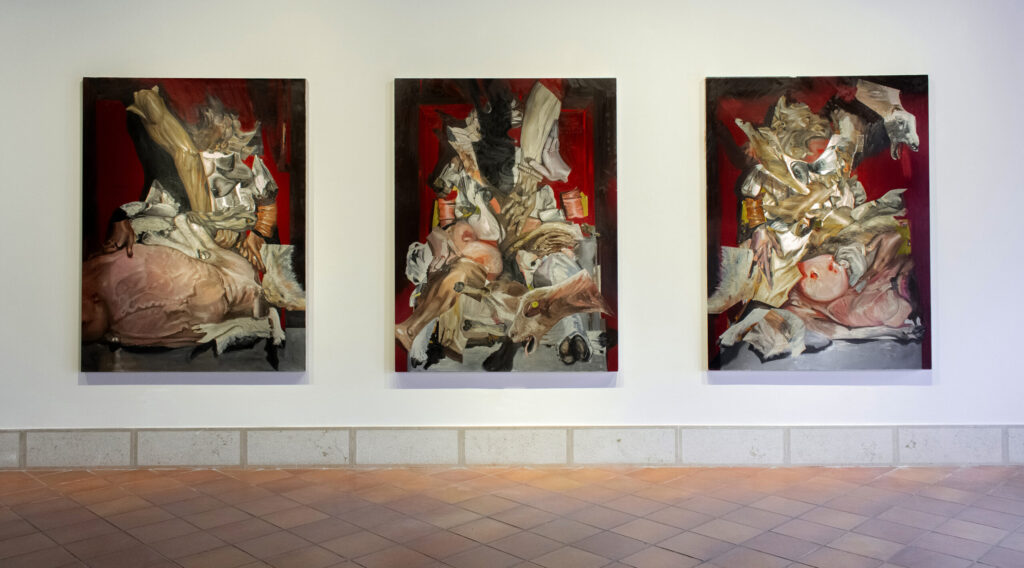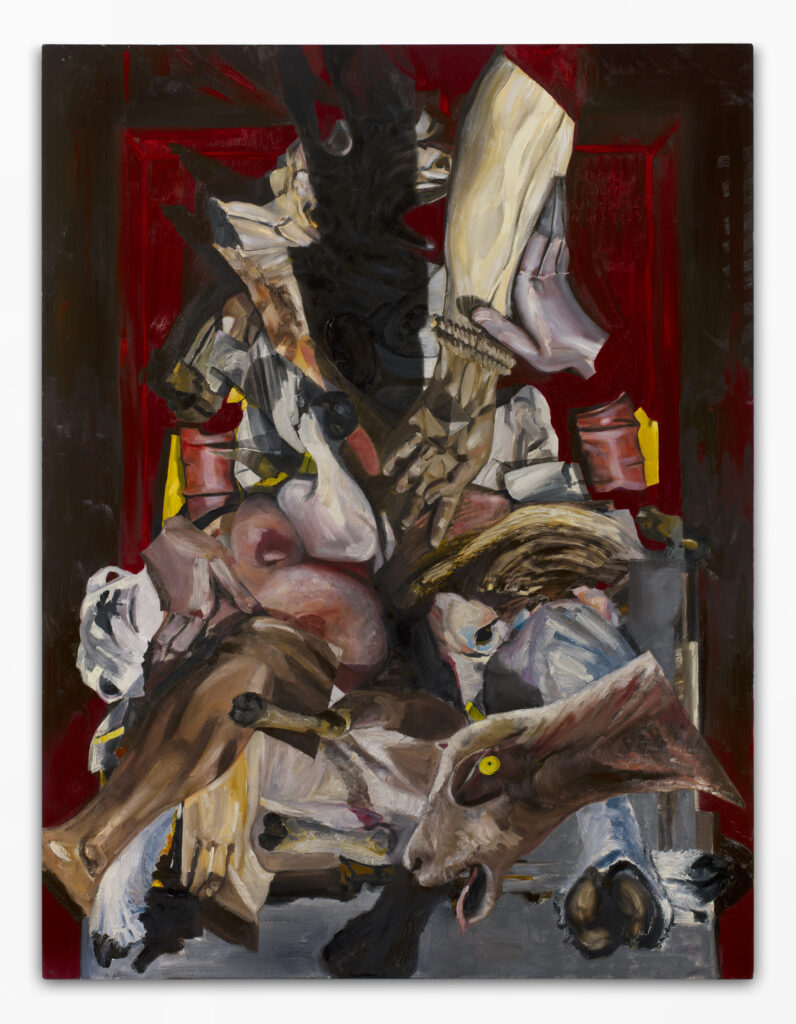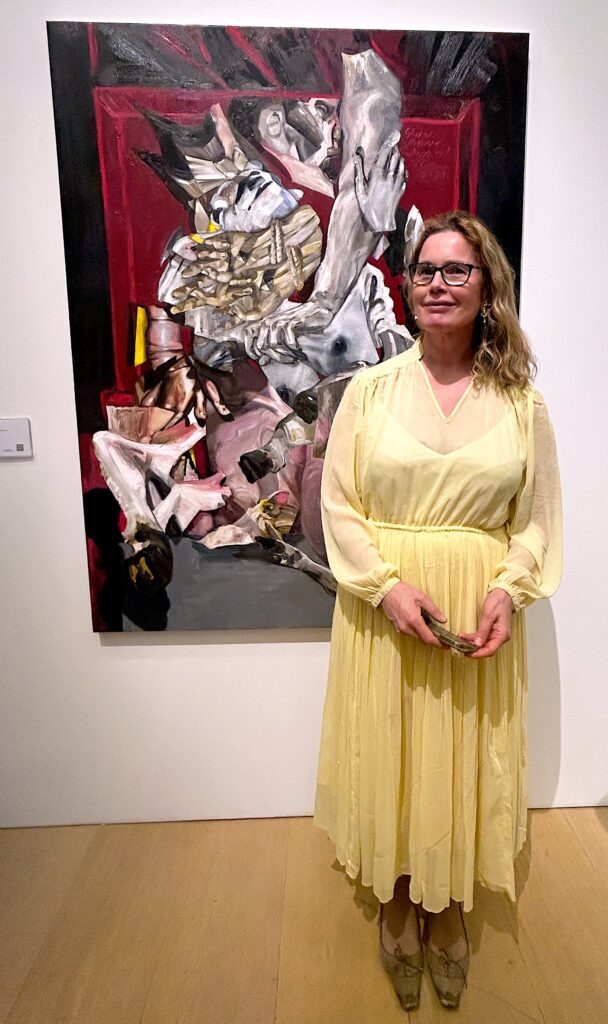W.K. Lyhne is a masterful painter whose visceral brushstrokes and powerful imagery evoke Francis Bacon’s primal Pope and animal portraits, with a nod to the religious ecstasy of 16th Century Spanish Mannerist El Greco. Lyhne’s bold impasto style and palette of earthy hues and blood-red paint, used to create violent scenes of writhing animal-human hybrid forms, pack a visual punch and at first glance might suggest the work of a male painter. Yet, these unforgettable images are the creations of a woman exploring notions of motherhood in the human and animal kingdom, through popular depictions of the Virgin Mary in her grief at the death of Jesus. Lyhne’s epic tableaux hark back to another era of imagery inspired by religious iconography, whilst examining the existential and physical struggles of women in a similar way to the late Paula Rego.

The London-based contemporary artist is making a big impression on the contemporary art scene globally, with a recent exhibition at Patricia Low Contemporary in Gstaad and a solo exhibition at Patricia Low Contemporary in Venice (until 6th April, 2024). Lyhne is also exhibiting in the brilliant group show ‘Seeing Red’ at Phillips in London (curated by Fru Tholstrup and Jane Neal).
Lyhne is the British School at Athens Arts research Scholarship Holder (2022/3), and her work has recently been exhibited at the Walker Art Gallery in Liverpool (2023); and TJ Boulting, Lungley and Hales galleries in London (2022). She is the co-founder of the Sequested Art Prize, awarded for self-portraits created in the home and supported by the Arts Council Heritage Lottery Fund. Lyhne is currently completing a practice-based PhD with supervisors from Chelsea College of Arts, UAL and the University of Oxford, that explores the connections between maternal behaviour in animals and humans.
Culturalee caught up with W.K. Lyhne to talk about her influences and inspirations, the long overdue recognition of women artists by the art establishment, and why she works under the gender-neutral pseudonym of W.K. Lyhne.
You are exhibiting in the group exhibition ’Seeing Red’ at Phillips in London at the moment. How did you interpret the red theme in the painting your exhibiting?
My work is an extension of my current show at Patricia Low Contemporary and takes “Seeing Red” as ‘decidedly fucked off’. Historically our visual language for female suffering has tended to find beauty rather than injustice in women’s suffering, and so our visual culture lacks a framework for finding beauty in a vocal woman or a shouting mother. Think of all those tremulous Victorian paintings of women, or Europa on the Bull. This is important, because what we are able to see influences what we consider as urgent and meaningful.
My obsession with the Ewe, a female sheep, is rooted in its potential symbolism within Feminism. My latest show, in Venice – “The Surrogate” – examines lamb symbolism through a body of work inspired by the process of grieving of these ordinary farm animals and allies it with the ritualised loss of the Virgin Mary.
All my works in this series are called Stabat Mater. All called Pathosformel with a number. It means ‘standing mother’ or ‘propped mother’, and this work is the 12th in the series of paintings currently on show in Venice. The figure is shown here to us as propped, compressed, awkward, and struggles with the dual job of trying to contain, hold and support as well as resisting the weight of history and its canonical images and the commodified female form. The figure, formed from abstracted elements, both animal and sculptural, is metaphorically and systematically chopped and glued together in an attempt to hold.
Pathosformel is a term by Aby Warberg – meaning an attempt to make a shorthand a pneumonic if you like, of extreme affective intensity. All my paintings in The Surrogate Series are attempts at this. The Surrogate refers to the actual mother performing the animal functions of mothering, instead of the static religious trope. Stabat Mater, literally translates as ‘Standing Mother’, in these works becomes the Stand-In Mother, i.e. the surrogate.

Your exhibition ’The Surrogate’ is at Patricia Low Contemporary in Venice at the moment. The exhibition features works exploring the Western visualisation of female pain and anger, and each piece is named after the Stabat Mater, a 13th Century hymn that reimagines the Virgin Mary’s suffering at the death of her son. How did you come across this hymn, and what was it that attracted you to the enigma of the Virgin as a focal point your paintings?
Stabat Mater refers to the only time the virtually mute Mary is vocal, makes a noise, or takes up space. It is the sound version of the Pietà, but these works are not Pietà’s, they are the scream you can see but not hear. In the painting in ‘Seeing Red’ at Phillips, the latest in the series, she is bounded and compressed, pushing against and held together by the shallow red picture plane – shouting her fury in rage and loss and questioning what Motherhood is asked to hold. There is almost no space for her to occupy. The animal in her breaks out. I relay that to the experience of the modern farm ewe. This is the subject of an upcoming collaborative film project I’m working on.
There are echoes of El Greco Velazquez, Picasso, Francis Bacon and Paula Rego in your paintings. Would you cite any of those artists as influences?
Who wouldn’t? I think we all are influenced by the canon old and new. Art is a continuous process – it’s made by the whole culture – not in a silo. That’s why my figures are railing against the traditional male canon. I include Michelangelo (the arm in the Bandini) and Giambologna and others. Bit obsessed with Holbein as it happens – I include ‘The Ambassadors’ in my Stabat Mater Pathosformel 6. The Ewe half head in the middle of my painting is referring to the strange anamorphosis skull in the Ambassadors foreground. I include the fur from Ambassadors through those red works, as a nod to the animal providing the wealth (once again), as the stout gentlemen in the Holbein survey the objects of achievement and worldly domination.
Was it intentional that your artist name W.K.Lyhne is ambiguous as it isn’t gendered? I wonder if this is a way of standing up to the dominance of Western art history by male artists and the fact that auction prices for male artists still far outweigh those reached by women artists?
Yes. I didn’t want to be known as female. De Beauvoir reminds us that women are made from Adam’s supernumerary bone, ‘that humanity is male and man defines woman not in herself but as relative to him. He is the Subject , she is the Other.’
Jonathan Jones, writing about Holbein’s ‘Christ in the Tomb’ (the long thin one in Basel that is so shocking) corporality, says: ‘There is nothing Christlike about this body, nothing to set it apart. It is anyone’s corpse.’ But this is world in which the women all live, all women, every month, every child is a reminder of the mortal, bloody, messy, fleshy real. I’m so interested in how absent Mary’s corporeality is. She has the odd tear, maybe a tiny bit of milk decorously done, but otherwise she is sealed. Nothing exits her body, not even words. Whereas Jesus is all blood and guts in historical painting. That’s why the Ewe in the painting at Phillips is shown semi-strangled by Christ’s arms, repeated and repeated. His bodily suffering is the only show in town.

As a woman and an artist, do you feel the art world is becoming more gender-balanced with more one-woman exhibitions at major institutions, such as Yoko Ono at Tate Modern and Marina Abramovic at the Royal Academy of Arts?
Somewhat. But if you consider that Abramovic was the first women EVER in the main galleries of the Royal Academy of Arts – and that Angelica Kauffman and Mary Moser, joint founders of the RA, had to be portrayed as pictures on the wall of a group looking at a plaster of a male nude in the RA portrait by Zoffany of them all, we have only come some of the way.
I am interested in the intersection of the systemic oppression of women and its effect on ecology and climate change. I passionately believe that we can and need to find a position that does not vilify: the male, the European, or the human, but instead to activate multiple ways of constructing trans-disciplinary community, moving towards a relational, collaborative ontological subject. A place where different voices can be heard. We differ and those differences matter. We must seek to honour the materially grounded differential.

You are currently completing a PhD in the connections between maternal behaviour in animals and humans. How does the PhD inform and inspire your artistic practice?
It’s incredibly valuable, although hard to do, as it takes up so much time. Content is everything. If you do it right, you shouldn’t need to explain. When a painting works, it has an effect on the viewer – they feel it’s important to their existence, even if they don’t know why. I love that quote by Bacon (reported by Jonathan Liddell ) “the question is not what the painter meant : it’s what the paint he applied says“. That’s the job of art.
W.K. Lyhne is exhibiting in ‘Seeing Red’ at Phillips in London until 24th March, 2024: https://www.phillips.com/store/seeing-red
W.K. Lyhne ‘The Surrogate’ is at Patricia Low Contemporary in Venice until 6th April, 2024:
W.K. Lyhne
Instagram: @wklyhnestudio



